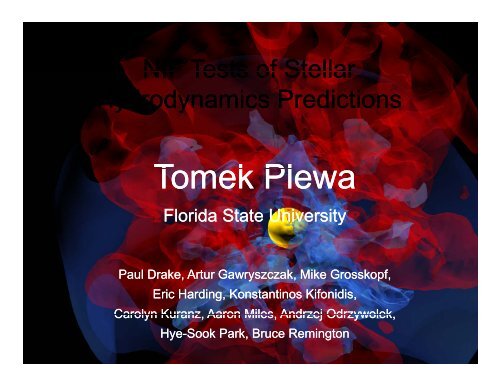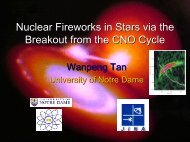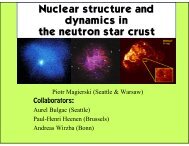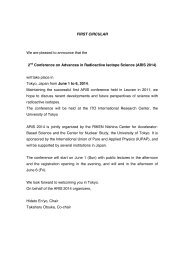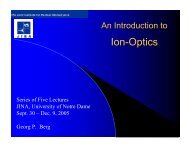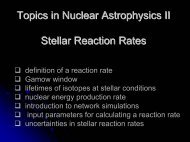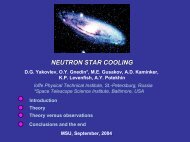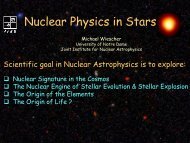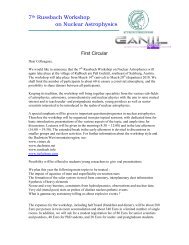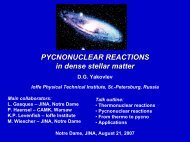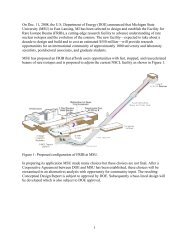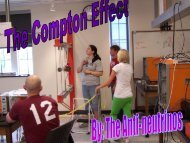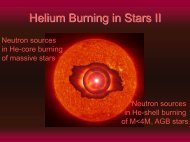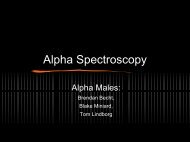Test of stellar hydrodynamics predictions
Test of stellar hydrodynamics predictions
Test of stellar hydrodynamics predictions
You also want an ePaper? Increase the reach of your titles
YUMPU automatically turns print PDFs into web optimized ePapers that Google loves.
NIF <strong>Test</strong>s <strong>of</strong> Stellar<br />
Hydrodynamics Predictions<br />
Tomek Plewa<br />
Florida State University<br />
Paul Drake, Artur Gawryszczak, Mike Grosskopf,<br />
Eric Harding, Konstantinos Kifonidis,<br />
Carolyn Kuranz, Aaron Miles, Andrzej Odrzywolek,<br />
Hye-Sook Park, Bruce Remington
Outline<br />
Supernovae<br />
Computations and Astrophysics<br />
HED Supernova Applications<br />
Nike: thermonuclear SNe: mergers, shear, and turbulence<br />
Omega: thermonuclear SNe: surprises on small scales<br />
NIF: core-collapse SNe: Diverging SN RT (SN 1987A)<br />
Discussion<br />
i<br />
April 26, 2011<br />
2
Our Stellar Neighbours<br />
Type II<br />
Massive<br />
Single<br />
H-rich<br />
Type Ia<br />
Medium<br />
mass<br />
Binary<br />
H/He-free<br />
White Dwarfs<br />
m < 1.4 Msun<br />
Brown Dwarfs<br />
m > 0.075075 Msun<br />
April 26, 2011<br />
3
Computational Astrophysics<br />
observation<br />
telescopes, satellites<br />
CCDs, spectrographs<br />
data analysis<br />
observations, errors<br />
theory<br />
model refinement<br />
motivate observing campaign<br />
physical interpretation<br />
mathematical model<br />
numerical representation<br />
simulation<br />
model observables<br />
model errors (convergence)<br />
computations<br />
April 26, 2011<br />
4
Computational Astrophysics<br />
A coupled set <strong>of</strong> PDEs and ODEs.<br />
<br />
t<br />
U F<br />
2<br />
4G<br />
U<br />
SU<br />
PDEs across the whole spectrum from elliptic (self-gravity) and<br />
parabolic problems (elemental diffusion) to hyperbolic systems<br />
(<strong>hydrodynamics</strong>).<br />
ODEs frequently stiff (nuclear reaction networks). The whole<br />
system might be stiff even if the individual components are not.<br />
One-dimensional problems <strong>of</strong> limited importance. Most interest<br />
in large-scale multidimensional applications.<br />
Temporal and spatial scales may vary vastly. Need methods<br />
adaptive in space and time. Andsubgrid scale models.<br />
Occasional flashy one-time hero-like demonstration runs,<br />
mostly beneficial to sponsors and/or public.<br />
Requires ”unlimited” computing power.<br />
April 26, 2011<br />
5
Verification, Validation, and Uncertainty<br />
Notion <strong>of</strong> validation is present in computational<br />
astrophysics<br />
Verification uses analytic solutions; (self-)convergence<br />
studies done almost exclusively in spatial domain<br />
Code-to-code comparisons since late1980s; several projects<br />
later; growing in popularity (self-confidence builders)<br />
Validation largely limited to “application to experiment”<br />
Low relevance is one major factor/relatively immature<br />
Historically more emphasis on observational rather than<br />
laboratory experiments<br />
UQ is mostly absent due to high “added” cost (discovery is<br />
valued much higher)<br />
April 26, 2011<br />
6
Thermonuclear Supernovae<br />
Type Ia<br />
Medium<br />
mass<br />
Binary<br />
H/He-free<br />
April 26, 2011<br />
7
SN Ia: Double Degenerates<br />
Double Degenerate (WD+WD) is alternative Type Ia SN<br />
formation channel to Single Degenerate (MS+WD)<br />
Possibly dominant in early type galaxies (Gilfanov & Bogdan<br />
2010), maybe overall…<br />
Theoretical studies<br />
Formation: Iben & Tutukov (1984)<br />
Rates: Han & Podsiadlowski (1994), Scannapieco & Bildsten (2005),<br />
Mannucci et al. (2005), Greggio (2005), Pritchet et al. (2008), Ruiter et<br />
al. (2009), Schawinski (2009)<br />
Merger models:<br />
1D: Nomoto & Iben (1985), Nomoto et al. (1991, AIC), Saio et al. (1989),<br />
Clayton et al. (2007, R CrB)<br />
2D: Mochkovitch & Livio (1989, 1990)<br />
3D:<br />
Unequal masses: Benz et al., Piersanti et al., Guerrero et al.,<br />
Segretain et al., Yoon et al., Loren-Aguilar et al.<br />
Equal masses: Pakmor et al. (2010, prompt ignition!!)<br />
April 26, 2011<br />
8
SN Ia: Double Degenerates<br />
Products <strong>of</strong> close binary <strong>stellar</strong> evolution<br />
Possibly similar intermediate <strong>stellar</strong> masses<br />
Two white dwarfs are end products <strong>of</strong> <strong>stellar</strong> evolution<br />
Rodriguez et al. (2007)<br />
April 26, 2011<br />
9
Shear, Turbulence, Combustion<br />
64 km<br />
April 26, 2011<br />
Work done in collaboration with A. Gawryszczak (Copernicus Center, Warsaw). Computing cycles: DOE NERSC.<br />
10
Quest for Thermonuclear Ignition<br />
April 26, 2011<br />
Work done in collaboration with A. Gawryszczak (Copernicus Center, Warsaw). Computing cycles: DOE NERSC.<br />
11
Supernovae Do Not Love Us Back!<br />
• Theory ultimately insufficient…<br />
• Computations not terribly successful… <br />
• Experiments…? :-\<br />
April 26, 2011<br />
12
HED Laboratory Astrophysics<br />
High Energy Density: p > 1 Mbar, energies > 10 11 J/m 3<br />
or > 10 12 erg/cm 3 , temperatures > 5x10 6 K or > 400 eV<br />
ICF<br />
radhydro<br />
HEDLA<br />
April 26, 2011<br />
Davidson et al. (2004)<br />
13
Supersonic Shear in HED Experiments<br />
Experimental setup (NIKE laser)<br />
Low-density material with machined sinusoidal perturbation<br />
High-velocity laser-driven flow<br />
Harding et al. (2010)<br />
Anticipated behavior<br />
Aluminum flows horizontally and drives a weak shock into the foam<br />
Horizontal shear between aluminum and shocked foam induces Kelvin-<br />
Helmholtz instability<br />
The flow near the interface is supersonic<br />
April 26, 2011<br />
14
Supersonic Shear in HED Experiments<br />
Observed behavior<br />
Harding et al. (2010)<br />
April 26, 2011<br />
15
Supersonic Shear in HED Experiments<br />
Observed detail; estimated Ma ~ 2.8<br />
Simulation results; estimated Ma ~ 6-8<br />
Possible explanations<br />
Lateral flow expansion neglected in hydro (2D) models<br />
EOS effects<br />
April 26, 2011<br />
16
SN Ia: Single Degenerates<br />
Products <strong>of</strong> close binary <strong>stellar</strong> evolution<br />
Unequal initial masses => different evolutionary timescales<br />
Primary evolves faster and becomes a white dwarf while the<br />
secondary becomes a (slightly) evolved non-degenerate<br />
companion<br />
NASA/D. Berry<br />
April 26, 2011<br />
17
Single-Point Central Ignition<br />
Linde & Plewa (2004)<br />
April 26, 2011<br />
18
RT-Unstable Supernova Flame<br />
Zhang et al. (2007)<br />
April 26, 2011<br />
19
Surprises from HED RT Experiments<br />
Smooth spike morphology<br />
Spike mass extensions<br />
Density pr<strong>of</strong>ile analysis<br />
Kuranz et al. (2009)<br />
April 26, 2011<br />
20
Successful Gedanke Experiments<br />
• Smooth spike morphology<br />
• Thermal conduction?<br />
Harden &<br />
Plewa (2009)<br />
• Spike mass extensions<br />
• Not seen in the above model with thermal conduction, nor in pure<br />
hydro models<br />
April 26, 2011<br />
21
Gedanke Experiments<br />
• Smooth spike morphology<br />
• Thermal conduction?<br />
Success!<br />
Harden &<br />
Plewa (2009)<br />
• Spike mass extensions<br />
• Not seen in the above model with thermal conduction, nor in pure<br />
hydro models<br />
Failure!<br />
April 26, 2011<br />
22
Discovery Science, At Last?<br />
• In-situ generation <strong>of</strong> magnetic fields via the Biermann battery<br />
mechanism (Kuranz et al. 2010)<br />
- cross <strong>of</strong> electron density and temperature gradients<br />
B<br />
t<br />
<br />
ck<br />
e<br />
B<br />
<br />
T<br />
e<br />
ln n<br />
- usually neglected term in the induction equation<br />
- induced magnetic field => extra pressure<br />
e<br />
<br />
• Consequences for supernovae<br />
• Magnetic pressure comparable to the thermal pressure at the<br />
thermonuclear deflagration front => possibly critical for SN Ia<br />
• Estimated negligible in core-collapse<br />
Fryxell et al. (2010)<br />
April 26, 2011<br />
23
Magnetized (Large Scale) RT Model<br />
negligible field:<br />
beta=250,000<br />
modest field:<br />
beta=2,500<br />
See also early work by Jun, Norman, & Stone (1995).<br />
April 26, 2011<br />
24
Core-Collapse Collapse Supernovae<br />
Type II<br />
Massive<br />
Single<br />
H-rich<br />
April 26, 2011<br />
25
Supernovae From Single Stars<br />
April 26, 2011<br />
26
Obs. #1: SN 1987A ejecta tomography<br />
Hanuschik et al. (1991)<br />
April 26, 2011<br />
27
Obs. #2: SN 1987A “mystery spot”<br />
Niesenson et al. (1987) Niesenson & Papaliolios (1999)<br />
April 26, 2011<br />
Wang et al. (2002)<br />
28
Core-Collapse Collapse SN Explosion Drive<br />
Massive stars<br />
Gravity bombs<br />
Energy extracted by neutrinos<br />
Accretion shock originally too weak<br />
Revived by neutrino heating <strong>of</strong> the post-shock matter<br />
April 26, 2011<br />
29
Standing Accretion Shock Instability<br />
Janka et al. (2006)<br />
April 26, 2011<br />
30
SASI in 3D<br />
Princeton<br />
LANL<br />
ORNL<br />
MPA<br />
FSU<br />
April 26, 2011<br />
31
Gedanke Experiment!<br />
Can We <strong>Test</strong> It?<br />
Ohnishi et al. (2008)<br />
• NIF design work w/Tim Handy at FSU in progress<br />
possible NIF design<br />
April 26, 2011<br />
32
Complex Post-Explosion SN Dynamics<br />
Triple<br />
Kelvin-Helmholtz<br />
Leading Shock Front<br />
Point<br />
Triple<br />
point<br />
Rayleigh-Taylor<br />
Rayleigh-Taylor<br />
Reverse Shock<br />
April 26, 2011<br />
Kelvin-Helmholtz<br />
Fallback<br />
Reverse Shock<br />
33
Origins <strong>of</strong> the Mixing: SN RT<br />
• Time-dependent deceleration <strong>of</strong> dense layers due to unsteady<br />
supernova shock motion though the progenitor envelope<br />
April 26, 2011<br />
34
Post-Explosion: Shocking the Envelope<br />
April 26, 2011<br />
35
Memory <strong>of</strong> the Explosion<br />
Angular evolution <strong>of</strong> the ejecta mass distribution<br />
expansion<br />
toward<br />
poles<br />
SASI imprint<br />
April 26, 2011<br />
36
56 Ni. How Much? How Fast?<br />
Following SN 1987A observations, 56 Ni distribution<br />
evolution is one <strong>of</strong> the primary model evaluation criteria<br />
April 26, 2011<br />
37
Toward Observables: Young ccSNR<br />
April 26, 2011<br />
38
HED <strong>Test</strong>s <strong>of</strong> ccSN RT Mixing<br />
• Motivated by SN 1987A<br />
• Theoretical foundations provided by HED scaling laws<br />
(D. Rytuov and collaborators)…<br />
April 26, 2011<br />
39
HED SN Experiment Scaling<br />
<br />
Formal challenge<br />
(no tough love)<br />
April 26, 2011<br />
Drake et al. (2002)<br />
40
HED <strong>Test</strong>s <strong>of</strong> ccSN RT Mixing<br />
• Motivated by SN 1987A<br />
• Theoretical foundations provided by HED scaling laws<br />
(D. Rytuov and collaborators)<br />
• Most work devoted to planar, two-layer targets (classic<br />
RT configuration)<br />
• But SN are largely spherical… => spherical targets and<br />
diverging flow configurations<br />
• Much more mass involved than in the planar case, thus<br />
requiring much more energy to drive<br />
• Early attempts (on Omega) unsuccessful (shell<br />
breakup) => NIF!<br />
April 26, 2011<br />
41
Diverging Supernova Explosion<br />
Experiments on NIF<br />
• NIF Facility Time (Rosner’s Committee)<br />
• Purpose: This experiment attempts to observe e extensive e Rayleigh-<br />
Taylor driven mixing in the exploding massive stars. Data will give<br />
physics insights <strong>of</strong> inter-shell penetration outwards to surface via<br />
turbulent mixing, shell breakouts, growth <strong>of</strong> secondary instabilities,<br />
vorticity-enhanced mixing.<br />
• 15 shots starting in AY 2012<br />
• Natural continuation <strong>of</strong> the previous work on Omega<br />
• NIF is unique facility enabling studies with spherical targets<br />
(diverging i flow geometry)<br />
• New diagnostics (IXTS, Dante, proton radiography…) in addition to<br />
standard diagnostics (x-ray radiography)<br />
April 26, 2011<br />
42
NIF DSNRT Diagnostics<br />
April 26, 2011<br />
43
NIF DSNRT Target<br />
Ag wedge pressure<br />
retainer<br />
0.1g/cc CRF foam<br />
0.1g/cc CRF foam<br />
1 g/cc CH<br />
CHI tracker,<br />
200 um wide<br />
small section<br />
in the middle<br />
0.0 6.528 mm radius<br />
0.728 1.928<br />
Cu or Ti<br />
Ripple interface<br />
0.928<br />
for some targets<br />
Ripple interface =xx m, =yy<br />
20 um<br />
for some targets<br />
mm<br />
thick CH<br />
=70-100 m,<br />
ablator<br />
=2.5-3.5 m<br />
inside<br />
April 26, 2011<br />
44
NIF DSNRT Design<br />
Grosskopf et al. (2011)<br />
April 26, 2011<br />
45
Summary<br />
SN Ia: Binary white dwarf mergers: shear and turbulence<br />
Unequal masses: no evidence for prompt ignition<br />
Equal masses: no evidence for prompt ignition<br />
Expect central ignitions with fast rotating envelopes<br />
Likely different from typical models with smooth rotation<br />
Perhaps similar to Yoon & Langer structure<br />
Shear/KHI HED studied and analyzed; HED turbulence experiment concept developed<br />
SN Ia: In-situ generated magnetic fields for Type Ia deflagrations<br />
Identified as a possible new physics in HED RTI experiments<br />
For supernova conditions, reduced turbulence near the flame<br />
Smoother flame surface<br />
Lower effective flame speed, large scales more important<br />
Flame remains RT-driven and mushroom-like in appearance<br />
SN II: Core-collapse<br />
Exploring possible SASI experimental designs<br />
SASI asymmetries may suffice to explain SN 1987A and alikes<br />
Crab-like spongy morphologies for young ccSNR<br />
Diverging SNRT to be executed on NIF!<br />
April 26, 2011<br />
46
April 26, 2011<br />
Questions and Discussion<br />
47


